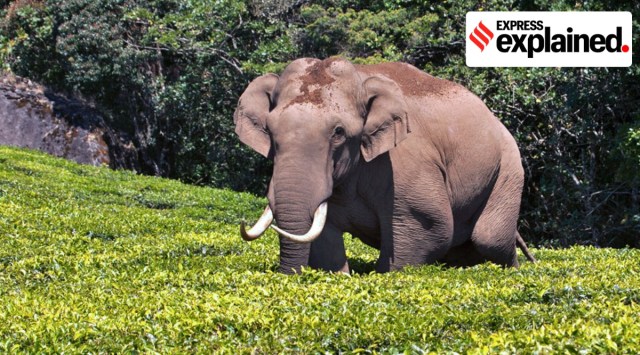Who is PT 7 and how will the captured havoc-wreaking elephant be relocated from Kerala?
Over the past two years, PT 7 has gained notoriety in Kerala for destroying property and endangering citizens. Capturing and transporting an adult elephant is far from easy. Here is how it will be done.
 An elephant strolling through a tea plantation in Kerala. (Representational, via Twitter/Munnar Forest Division)
An elephant strolling through a tea plantation in Kerala. (Representational, via Twitter/Munnar Forest Division) A wild elephant, which has been wreaking havoc in a few villages in Kerala’s Palakkad district for the past two years, was tranquilised by a forest department team on Sunday morning (January 22).
The elephant, code-named Palakkad Tusker-7 (PT 7 or Palakkad Tusker 7), was roaming inside the forest at Dhoni and neighbouring villages in the districts. On Saturday morning, a fully equipped team comprising 26 Forest Department officials entered the forest near Palakkad to neutralise the rogue elephant. The team led by Chief Veterinary Officer Arun Zachariah was to relocate it to the Wayanad Elephant Camp.
For the past two years, PT 7 built a notorious reputation in Kerala, frequently raiding farmland as well as residential areas across central Kerala, especially Palakkad and Idukki districts. According to Forest Department officials, it has been responsible for nearly 90 per cent of elephant conflicts in the region, reported The Hindu. Forest officials brought kumki elephants (elephants used to trap and train their wild counterparts) to guide the rogue jumbo into a truck to shift it to a secured place in the district.
Kerala Forest Minister A K Saseendran told PTI that the elephant will be shifted to a cage. He said the forest department will monitor the health of the tusker at the cage set up near Dhoni and take further action regarding its rehabilitation. “It might take at least six months to tame an elephant. We have to prepare a proper diet for the animal and train it,” Saseendran said.
PT7 and his violent exploits
PT 7 has terrorised the people of Kerala for the last two years. While local reports attribute over 500 incidents to the adult male tusker, an official Forest Department report in 2022 said that the tusker was involved in 176 crop raids and 13 incidents of property damage. Spending significant time outside the forest, near populated human settlements, PT 7 has frequently come in contact with humans, even posing a serious threat to life. Over the past couple of months, the elephant has gotten increasingly violent, often chasing and attacking humans/cars.
According to the Forest Department, the elephant’s increased aggression over the last couple of months can be attributed to the elephant showing signs of musth – a periodic state when bull elephants turn aggressive, often coinciding with the mating season.
Chief Wildlife Warden Ganga Singh took the decision to translocate PT 7 after the tusker charged at a rubber tapper in Dhoni, Palakkad on November 24, 2022, reported Manorama Online. The man tripped while running away, breaking his arm in the process. The incident sparked public protests in the district. In July, in the same village, PT 7 allegedly trampled a 60-year-old morning walker to death. The Forest Department, however, failed to identify the elephant responsible for it.
Capturing a rogue elephant
Capturing and transporting a fully-grown adult elephant is far from easy. Since late November, authorities have meticulously planned an operation that would see PT 7 be tranquilised and transported to an elephant camp in Wayanad. The team includes 26 members of the Rapid Response Team in an active role with three trained kumki elephants to assist. Fifty forest guards were on call as well, responsible for securing the area.
A tracking team planned to enter the forest near Dhoni and once his whereabouts are ascertained, he was to be shot with tranquiliser darts.
While films make darting look as easy as shooting an animal, in real life, it is a complicated process. First, unlike bullets which may be shot from even a few kilometres away (using sniper rifles), the maximum range of dart guns is about 50-75 metres, which gets further lowered in a dense forest. This means that the team has to get very close to the aggressive animal. Second, the amount of tranquillisation medication required and the time it will take to take effect will depend on the size of the elephant.
Once this is done, with the help of the three trained kumki elephants, the elephant would be put into a lorry which will transport him to a kraal – enclosure built to tame wild elephants. Till such time he enters the kraal, he will be under heavy sedation, with vets possibly having to inject multiple doses during the translocation.
Increasing human-elephant conflict
PT7’s story has evoked strong reactions in Kerala. While for those living under the shadow of its destructive presence, the Forest Department’s intervention comes as much-needed relief, others are more sympathetic to its plight. Increased urbanisation and human encroachment into prime elephant territory as one of the reasons for such cases of elephants’ temper tantrums.
As a result of habitat loss and fragmentation, elephants often come in contact with humans while foraging for food or migrating from one place to another, a World Wildlife Fund report said. Human-elephant conflict caused 1,401 human and 301 elephant deaths in India from 2018-2020, Bhupendra Yadav, Union minister for environment, forest and climate told the Rajya Sabha August 2, 2021.
While state governments and the central government have come up with task forces and various laws to help address the issue, the fundamental problem of human encroachment into the habitat remains an issue.
- 01
- 02
- 03
- 04
- 05






































